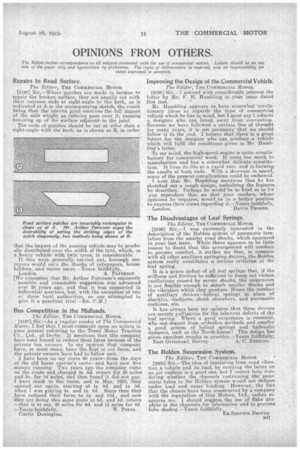OPINIONS FROM OTHERS.
Page 25

If you've noticed an error in this article please click here to report it so we can fix it.
The Editor invites correspotwlence on all subjects connected with the use of commercial motors. Letters should be on one side of the paper only and typewritten by preference. The right of abbreviation is reserved, and no responsibility for views expressed is accepted.
Repairs to Road Surface.
The Editor, THE COMMERCIAL MOTOR.
[2196] Sir,—Where patches are made in tarmac to repair the broken surface, they are usually cut with their extreme ends at right-angIe to the kerb, as is indicated at A in the accompanying sketch, the result being that the uneven joint receives the full impact of the axle weight as vehicles pass over it; causing breaking up of the surface adjacent to the joint.
The ends of patches Should be cut at other than a right-angle with the kerb, as is shown at B, in order
that the impact of the passing vehicle may be gradually distributed over the width of the tyre, which, in a heavy vehicle with twin tyres, is considerable. If this were generally carried out, borough surveyors would earn the thanks of ratepayers, househcilders, and motor users.—Yours faithfully,
London. A. PATERSON.
[We remember that Mr. Arthur Paterson's eminently sensible and reasonable suggestion was advanced over 20 .years ago, and that it was supported in influential quarters, but, with the exception of two or three local authorities, no one attempted to give it a practical trial.—ED. Calf.]
Bus Competition in the Midlands.
The Editor, Tax COMMERCIAL MOTOR.
[2197] Sir,—As a regular reader of The Commercial Motor, I feel that I must comment upon an article in your journal referring to the Trent Motor Traction Co., Ltd., of Derby. It mentions that this company have been forced to reduce their fares because of the private bus owners. In my opinion that company have, in most eases, been the first to cut fares, and the private owners have had to follow suit.
I have been on my route 20 years—from the days of the old horse carrier's carts—and have now five motors running. Two years b.,go the company came on the route and charged 3s. 6d. return for 20 miles and 3s.for 14 miles, and then found it did not pay. I have stuck to the route, and in May, 1923; they opened out again, starting at is. 9d. and is. 3d. when I was getting 2s. and is. 8d. Since then they have reduced their fares to is. and 10d., and now they are doing this same -route at 6d. and '4d. return --that is to say, 20 miles for 6d. and 14 miles for 4d.
—Yours faithfully, W. POTTS. Castle Donington.
Improving the Design of the Commercial Vehicle.
The Editor, THE COMMERCIAL MOTOR.
[2198j Sir —I noticed with considerable interest the letter by Mr. F. IL Rambling in your issue dated 21st inst.
Mr. Hambling appears to have somewhat revolu tionary ideas as regards the type of commercial vehicle which he has in mind, but I must•say I admire a designer who can break away from convention. Because we have followed a certain line of thought for many years, it is not necessary that we should follow it to the end. I believe that there is a great future for the designer who can produce a vehicle which will -fulfil the conditions given in Mr. Han& ling's letter.
To my mind, the high-speed engine is quite unsatis factory fer commercial work. It costs too much to manufacture and has a somewhat delicate constitution. It lives its life at a rapid rate, and is burning the candle at both ends. With a decrease in speed, many of the present complications could be eschewed.
I note that Mr. Rambling mentions that he has sketched out a rough design, embodying the features he describes. Perhaps he would be so kind as to let you reproduce this, so that your readers, whose opinions he requires, would,be in a better position to express their views regarding it.—Yours faithfully, London. . DAVID THORNE.
The Disadvantages of Leaf Springs.
The Editor, THE COMMERCIAL MOTOR.
[2199] Sir,—I was extremely interested in the description a the Holden system of pneumatic insulation from the smaller road shocks, which appeared in your last issue. While there appears to be little reason to doubt that this arrangement will conduce to greater comfort, it strikes me that, in common with all other auxiliary springing devices, the Holden system really constitutes a serious criticism of the leaf spring.
It is a grave defect of all leaf springs that, if the stiffness and friction be sufficient to damp out violent oscillations caused by severe shocks, the suspension is not flexible enough to absorb smaller shocks and the vibration which they produce. Hence the number of auxiliary devices—helical prings in place of shackles, dashpots, shock absorbers, and pneumatic cushions, etc.
It has always been my opinion that these devices are merely palliatives for the inherent defects of the leaf spring. Where a good suspension is 'essential, why -not depart from orthodox methods and employ a good system of helical springs and hydraulic dampers, such as the North-Lucas? This design has given excellent results in nraetice.--Yours faithfully,
East Grinstead, Surrey. A. C. JENKINS.
The Holden Suspension System. •
The Editor, THE COMMERCIAL MOTOR. 4 [2200] Sir,—The-idea of insulating from road vibration a vehicle and its load, by carrying the latter on an air cushion is a good one, but T cannot help wondering whether the channels restraining the pneumatic tubes in the Holden system would not deform under load and cause binding. However, the fact that the chassis have been constructed by a company with the reputation of Guy Motors, Ltd., rather reassures me. I should suggest the use of flake graphite in the channels for lubrication and to prevent tube chafing.—Yours faithfully,
ER-SERVICE DRIVER.




























